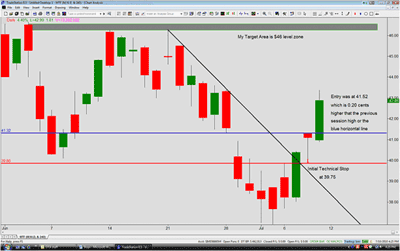Recently, I was asked a question about option trading and the placing of stops. I felt that the topic of stop losses and options needed to be explained in detail, so I wrote an explanation for MoneyShow.com readers.
In this article, I will share one of my anonymous current long trades. The aim is to explain my logic behind placing the stops at the levels that I have seen appropriate. Just a note, there are many different types of stops, such as time stops, trailing stops, technical stops, and so on. Also, there is no conventional agreement among traders about what stops should be used for which occasion. Basically, there are as many different applications of these stops as there are different traders. The style that I am describing here is my way of managing the risk. If you, the reader, happen to read some other trader's discussion on stops, then most likely, it will vary from mine.
Keep on reading this article with an open mind, and if this form of stop placement makes logical sense to you personally, then go ahead and utilize it. If the risk-to-reward does not fit your liking, then dismiss it and develop a style of your own. In any case, beware that there is no one-size-fits-all solution.
Before placing any trade, one must be clear on the duration that the trade is going to be. In the case of my trade, it is a swing trade and not an intraday scalp. Hence, when looking at the chart, I analyze the daily chart for the simple reason that I might be in this trade for a matter of days. It is off of the daily chart that I am selecting my targets and my stops. I like to call my stop selection S.E.T., which is an easy abbreviation for the following: S is for stop, E is for entry, and T is for target. Out of these three, the first in line is actually the stop. For any given trade, even before I enter it, I must be clear on how much I am willing to risk/lose. Many novices completely skip, in my opinion, the most important part of the trade: Risk management. The ideal ratio would be risking one point to make three points. This is often referred to as 3:1. Although the first number (3) stands for the reward, and the last one (1) for risk, counts not how much you might make first, but how much are you willing to lose.
The figure below shows an unnamed underlying which I have first analyzed on the monthly scale, then on the weekly, and finally on the daily. Once again, it is off the daily that I have placed my technical stop. I emphasize the word technical stop to distinguish it from the other two. The technical stop is placed based off of the technical analysis. The time stop is based on the amount of time that the trader has chosen to be in the trade. By the way, to us option traders, time is always an issue, so do not ignore the time dimension in your option trading. The trailing stop is nothing else but profit protection. Many times, my students tell me that as soon as they enter their trades, they place trailing stops. This line of thinking, by itself, is contradictory. At the moment of entry, there is no profit; hence, a trailing stop makes no sense.
The technical stop is my initial stop. Again, the emphasis is placed on the word initial. Once the trade moves in my direction and comes near my targeted area, then the initial stop could be replaced by a trailing stop.
This was a long trade, a bull call debit spread to be exact, but the specific strike prices aren't pertinent to the discussion of stops in this article. I chose to place my stop at $39.75, below the low of $39.86 from the previous trading session (red horizontal line). My entry was done when the underlying had taken out the high (blue horizontal line) of the previous session. Specifically, the high was $41.32 and my entry was only 20 cents higher, for I wanted to be certain that this was a true breakout.
At the end of the day, when the market closed, I manually moved my stop from one low to the new low, which was just below $41. This means that at the time of writing my article, my entry at $41.52 and my new stops are only about 50 cents apart. Thus far, the trade is going in my favor. The target is at $46 (gray horizontal area), which gives a reward-to-risk ratio that is greater than the one described above as 3:1.
In conclusion, I have defined and addressed the difference between three types of stops: trailing stops, time stops, and technical stops. I have described technical stops in greater detail by utilizing the visuals of one of my current long trades. Each of my trades have a technical stop, which is only the initial stop. If the trade does not work out according to my forecast, then these stops remain where they were initially placed.
Technical stops are hard, or mechanical stops. They are entered in the platform and they get executed when the conditions are met. For a long trade, the condition to exit for a loss is when the product is at or below a certain price; the short trade's condition to exit is when the product is at or above a certain price. Lastly, make sure that you are familiar with how to place stops on your trading platform.
By Josip Causic, instructor, Online Trading Academy





















